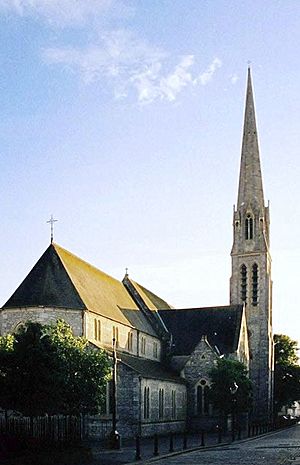Plymouth Cathedral facts for kids
Quick facts for kids Plymouth Cathedral |
|
|---|---|
| Cathedral Church of Saint Mary and Saint Boniface | |

View of the cathedral from the north east
|
|
| Lua error in Module:Location_map at line 420: attempt to index field 'wikibase' (a nil value). | |
| OS grid reference | SX4710054859 |
| Location | Plymouth, Devon |
| Country | England |
| Denomination | Roman Catholic |
| Website | plymouthcathedral.co.uk |
| History | |
| Status | Active |
| Consecrated | 1880 |
| Architecture | |
| Heritage designation | Grade II |
| Designated | 1 May 1975 |
| Architect(s) | J. A. Hansom |
| Style | Early English Gothic |
| Years built | 1856—1858 |
| Specifications | |
| Spire height | 61 metres (200 feet) |
| Administration | |
| Deanery | Plymouth |
| Diocese | Plymouth (since 1850) |
| Province | Province of Southwark (since 1965) |
The Cathedral Church of Saint Mary and Saint Boniface is a very important church in Plymouth, England. It is the main church for the Bishop of Plymouth. It is also the "mother church" for the Roman Catholic Diocese of Plymouth. This area covers Cornwall, Devon, and Dorset.
The Diocese of Plymouth was started in 1850. The new cathedral opened in 1858. It was named after the Virgin Mary and Saint Boniface. Saint Boniface is believed to have been born nearby in Crediton.
The cathedral is also used by people from the Royal Navy. They are stationed at HMNB Devonport. They have a special naval mass there every July.
Contents
History of Plymouth Cathedral
How the Cathedral Started
Before a big change called the Reformation, Exeter Cathedral was the main church for bishops. Their area included all of Devon and Cornwall. In 1850, a new Catholic church structure was set up. Plymouth became the center for Cornwall, Devon, and Dorset.
The first bishop was chosen on July 25, 1851. His name was George Errington. He was from Yorkshire. He was known for visiting Dartmoor Prison every week. Four years later, Errington became a special helper to the Archbishop of Westminster. On July 19, 1855, William Vaughan from Bristol became the new Bishop of Plymouth.
Building the Cathedral
Since the diocese began, a small church called Saint Mary's was used. It was built in 1807 on Saint Mary Street. Bishop Vaughan decided to build a new, bigger cathedral. On February 20, 1856, he bought some land outside the town.
The land cost £3,904. Mr. Bastard gave £1,000. The rest of the money was collected from people in the diocese and other parts of England. Joseph Hansom and Charles Hansom were the architects. Local builders from Stonehouse did the construction work.
Work started on June 22. During this time, a Royal Navy officer fired new Turkish guns in Plymouth Sound. This caused the ground to shake a bit. The cathedral officially opened with a Mass on March 25, 1858. This day is known as the Feast of the Annunciation. Bishop Vaughan officially consecrated the cathedral on September 22, 1880.
The Convent School
On July 26, 1860, a group of nuns called the Sisters of Notre Dame de Namur came to Plymouth. They helped run schools for children who needed support. They first stayed at St Mary's Church.
On October 19, 1858, they bought land near the cathedral. They opened a convent and a school for girls there. Girls could live at the school or just attend during the day. This school was closed after it was bombed during the Plymouth Blitz in 1941. The area is now a residential complex with homes. The Notre Dame Catholic School is now located in the Plymouth area of Derriford.
See also
 In Spanish: Catedral de Santa María y San Bonifacio (Plymouth) para niños
In Spanish: Catedral de Santa María y San Bonifacio (Plymouth) para niños
- Roman Catholic Bishop of Plymouth
- St Boniface's Catholic College

